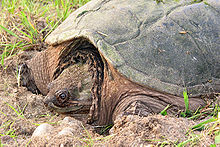Chelydridae
| Chelydridae Temporal range: 70.6–0 Ma Late Cretaceous to Recent |
|
|---|---|
 |
|
| The common snapping turtle (Chelydra serpentina) a species of Chelydridae | |
| Scientific classification | |
| Kingdom: | Animalia |
| Phylum: | Chordata |
| Class: | Reptilia |
| Order: | Testudines |
| Suborder: | Cryptodira |
| Clade: | Americhelydia |
| Family: |
Chelydridae Gray, 1831 |
| Genera | |
| Synonyms | |
|
|
The Chelydridae are a family of turtles that has seven extinct and two extant genera. The extant genera are the snapping turtles Chelydra and Macrochelys. Both are endemic to the Western Hemisphere. The extinct genera are Acherontemys, Chelydrops, Chelydropsis, Emarginachelys, Macrocephalochelys, Planiplastron, and .
The Chelydridae have a long fossil history, with extinct species reported from North America, all over Asia and Europe, far outside their present range. The earliest described chelydrid is Emarginachelys cretacea, known from well-preserved fossils from the Maastrichtian stage of the Late Cretaceous of Montana. Another well-preserved fossil chelydrid is the Late Paleocene from North Dakota. The carapace of P. zangerli is higher domed than that of the recent Chelydra, a trait conjectured to be associated with the coexistence of large, chelonivorous (i.e., turtle-eating) crocodilians. Another genus, Chelydropsis, contains several well-known Eurasian chelydrid species that existed from the Oligocene to the Pliocene.
...
Wikipedia
